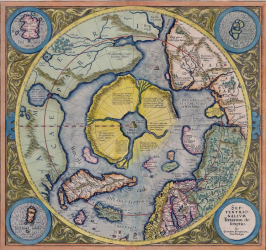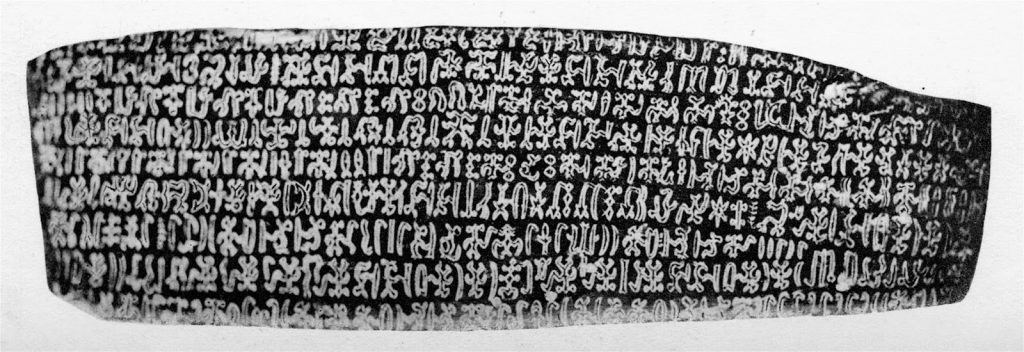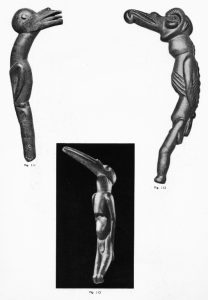
Robert Schoch
Easter Island (Rapa Nui; Isla de Pascua) is a tiny speck of land, a mere 64 square miles, in the South Pacific just below the Tropic of Capricorn, 2300 miles west of South America. The closest inhabited land, Pitcairn Island (where mutineers of the Bounty settled in 1790), is over 1200 miles to the west.
The moai, those giant heads and torsos of Easter Island, are emblematic of ancient mysteries and lost civilizations. Viewing them firsthand in all their magnificence during a recent geological reconnaissance trip to Easter Island, I could only be impressed. Carving, transporting, and erecting these inscrutable megalithic statues (some of which are over 30 feet tall and weigh tens of tons) was no mean feat. Surely they reflect a sophisticated society of which we are but dimly aware. Yet, conventional archaeologists have considered the big heads to be, well, big heads— the product of a Stone Age culture that spent its energy carving monotonously stereotypic megalithic monuments as part of some primitive religion, perhaps ancestor worship, or simply as busy work devised by the ruling elite to keep the populace in line on an island from which there was no escape.

The moai are fascinating, and by applying geological expertise to the problem of their chronology (as I did for the Great Sphinx in Egypt), new light might be shed on the island’s enigmas. I hope to organize a full-fledged geological expedition to the island and pursue such research. But the moai, literally the biggest mystery in terms of their physical size (an unfinished moai still in the quarry is over 60 feet long), are not alone when it comes to the perplexities of Rapa Nui. Though tiny in physical comparison, inscribed wooden tablets have been the subject of curiosity and heated debate ever since they came to the attention of nineteenth century European missionaries.
Numerous wooden tablets covered with a strange hieroglyphic-like script were found in many of the natives’ houses, according to Brother Joseph-Eugène Eyraud, reporting to his superiors in Paris. The writing became known as rongorongo (“lines of inscriptions for recitation”). Unfortunately between the missionaries’ zeal, attempting to separate their new converts from old pagan ways, and internecine warfare, almost all of the rongorongo tablets were burnt or otherwise destroyed. Today just upwards of two dozen remain. Furthermore, those natives literate in rongorongo were killed in fighting, succumbed to disease, or were carried off the island in slave raids. By the late nineteenth century, no one could genuinely read the rongorongo script, and to this day nobody has put forth a convincing decipherment.
I became fascinated by rongoronogo, immersing myself in the voluminous literature on the subject and pursuing firsthand analyses of the script. There is no agreement among researchers concerning even the fundamentals of rongorongo. How far back in time it may go is a subject of debate. Some scholars assert it was invented on Easter Island during the late eighteenth century, in imitation of European writing the natives had observed. Others believe that rongorongo traces its ancestry back thousands of years, though the surviving wooden tablets are at most a couple of hundred years old. Indeed, the known tablets could simply be copies of copies of copies . . . Perhaps the scribes, for many centuries, were not able to truly read the script but piously copied and recopied something they knew was important and held in reverence. Brother Eyraud wrote in 1864, “But the little they [the Easter Islanders] make of these tablets persuades me to think that these characters, probably a script in origin, are for them now just simply a custom they preserve without attempting to account for it” (quoted by S. R. Fischer, Rongorongo, 1997, p. 12).
Far from being an indigenous creation of the Easter Islanders, some researchers suggest that the rongorongo script originated in parts of Polynesia well west of Easter Island, or perhaps even in China. Others look to South America for its origins. Still others have seen similarities between rongorongo characters and the enigmatic ancient scripts of the Indus Valley civilization of modern Pakistan and neighboring regions. One researcher seriously suggested that rongorongo might be related to ancient Egyptian hieroglyphics. I have long advocated that there is good evidence supporting cultural contact across both the Pacific and Atlantic Oceans in remote ancient times (see my book Voyages of the Pyramid Builders), so I do not automatically revile diffusionist ideas as many conventional archaeologists and historians do. But looking carefully at such rongorongo analyses, I do not find them particularly convincing. A stylized fish, human figure, Sun, or vulva could conceivably look similar across unconnected cultures. Or, might ancient Chinese scripts, Indus Valley scripts, Egyptian hieroglyphics, and rongorongo all stem from a common source or inspiration?
Perhaps simply treating rongorongo as a script, as a form of writing comparable to a European alphabetical language, or even as a script based on pictographs, ideographs, or hieroglyphics, is either the wrong approach, or an incomplete approach. Here I offer a different interpretation of rongorongo, an idea initially suggested to me by my wife, Catherine Ulissey.
Just back from Easter Island (January 2010), steeped in the conundrums of its history and culture, I could not get my mind off of rongorongo (as well as other enigmas of the island). One evening, needing some relaxation, Katie insisted that we re-watch the video Symbols of an Alien Sky, Episode One (MIKAMAR Publishing, 2009), written and narrated by David Talbott. Katie had the hunch it might pertain to the questions we were grappling with concerning Easter Island. In the video Talbott, author of the 1980 book The Saturn Myth, discusses his conclusion, based on mythologies collected around the world, that the sky was very different in ancient times, and Earth and the solar system underwent major upheavals. For those familiar with the writings of Immanuel Velikovsky, it should come as no surprise that Talbott was influenced and inspired by the research of that great heretical scholar.
In the Symbols video, Talbott discusses the work of Los Alamos National Laboratory physicist Dr. Anthony L. Peratt, a specialist in plasma physics. Plasma, sometimes referred to as the fourth state of matter (in addition to solids, liquids, and gases), consists of ions (electrically charged atoms or particles) and is perhaps most familiar in such forms as lightning, fire, or the glowing material in a neon tube. Auroras, the northern and southern polar lights, are also the result of plasma phenomena, caused by interactions between the solar wind (plasma emitted by the Sun) and Earth’s magnetic field and magnetosphere.

Powerful plasma phenomena form various diagnostic configurations. Some look like intertwining snakes or pieces of rope, others like stacks of circles. In fact, plasma columns can expand in places and form donut shapes and cup shapes and become narrow at other points (due to what are known as “pinch instabilities”). In profile these plasma columns may look remarkably like human stick figures, with an upper cup shape (head) that has the appearance of a bird in profile. Peratt, when he first studied ancient petroglyphs (carvings on rocks), was struck that many appear to mimic plasma configurations.
For a number of years, Peratt and his team of researchers have been documenting the occurrence of ancient petroglyphs around the world that appear to represent plasma configurations (their work can be found in the Institute of Electrical and Electronic Engineers Transactions on Plasma Science, December 2003 and August 2007). But how do they explain these plasma configurations apparently recorded by ancient peoples in the form of petroglyphs? Today the auroras are typically seen only at very high latitudes and apparently with none of the strength resulting in the diagnostic configurations recorded in ancient times. Peratt suggests that there was a major solar plasma outburst thousands of years ago. Earth may have been subject to solar plasma winds up to hundreds of times stronger than current solar winds!
Peratt’s work is incredibly exciting in its own right, but I think there is more. The figures of the rongorongo script are curiously similar to many petroglyphs found repeatedly around the world—from Australia to Arabia, to North and South America, to Mongolia, and everywhere in between. Even on Easter Island petroglyphs are found abundantly. As we watched the Symbols video, Katie turned to me and suggested that the rongorongo script, just like many of the petroglyphs, may have been inspired by the observation of plasma configurations in the ancient skies.
The more I thought about it, the more compelling I found the suggestion that rongorongo records observations—very important and unusual observations—in the skies of long ago. Indeed, I felt confident enough that this was a hypothesis worthy of serious consideration to announce the idea during my presentation at the International Conference on Ancient Studies in Dubai on 13 February 2010. Supporting this interpretation are native terms and legends from Easter Island. Francis Mazière records an indigenous name for the island as “Matakiterani,” or “eyes gazing at the sky” (Mysteries of Easter Island, 1968, p. 9). He also records a legend of the sky falling:
In the days of Rokoroko He Tau the sky fell. Fell from above on to the earth. The people cried out, ‘The sky has fallen in the days of King Rokoroko He Tau.’ He took hold: he waited a given time. The sky returned; it went away and it stayed up there.
This legend could refer to strange plasma configurations, perhaps even manifested in part as tremendous bolts of lightning, seen in the sky and making contact with the land. Subsequently the plasma “went away” and the sky returned to normal. Also, and perhaps it is only a coincidence, the legendary king’s name bears a striking similarity to “rongorongo” and “Tau” is similar to “ta’u,” a category of inscriptions commemorating a series of deeds or events (Fischer, 1997, p. 288). When a staff covered with rongorongo texts was collected in 1870 by Chilean naval officers, the commander Don Anacleto Goñi reported that the natives could not decipher them but “we, in asking explanations of the natives about said staff, were shown the sky and the hieroglyphs that [the staff] contained with such respect that I was inclined to believe that these hieroglyphs recalled something sacred” (quoted by Fischer, 1997, p. 26).
Peratt posits that the plasma configurations recorded worldwide on petroglyphs may date, very roughly, to the Neolithic or Early Bronze Age (that is somewhere around 12,000 to 5,000 years ago, beginning at the end of the last ice age). Peratt and his team have established, based on the distributions and orientations of petroglyphs, that the ancient auroras and plasma configurations resulted from a plasma flow directed predominantly toward Earth’s south pole. Concerning Easter Island in particular, they determined that the main petroglyph sites have a southern field of view from which such a plasma flow would be best observed.
The rongorongo script appears to share elements in common with the petroglyphs of Easter Island, such as the image of a birdman. Remarkably, according to Peratt’s work, the birdman motif may have been inspired by the characteristics of a plasma column, and the concept of a post, staff, or human-like body surmounted by a bird for a head is found around the globe. In my assessment, rongorongo is not just a portable form of petroglyph equivalents inscribed on wood. Petroglyphs, for the most part, are found either isolated or in small groups and are often seemingly randomly scratched or carved over rock surfaces. I suspect rongorongo is something of a book, a scientific text that records, at least in part, plasma configurations observed in the ancient skies from Easter Island. On these tablets the glyphs are carved in neat linear lines, perhaps recording plasma configurations as seen sequentially, possibly with some “commentary” on, or “punctuation” between events. They may be a record of exactly what was happening in the skies, in what order, and perhaps even for how long.
If this hypothesis has merit, what might have caused the plasma events recorded by the Easter Islanders? Several thoughts come to mind. Peratt, as noted above, suggests that intense solar discharges, possibly on the order of hundreds of times stronger than any such phenomena observed in historical times, could be the culprit. Solar outbursts may have rained down lightning-like discharges. Intense heat associated with such electrical discharges may have reached Earth’s surface in places, causing the melting and vitrification of rock (literally turning it to glass), the evaporation of bodies of water, and the incineration of all organic material (including any humans!) hit by the onslaught. In some cases, I speculate, the damage was very narrowly focused, analogous to the damage of a tornado. The way to save oneself may have been to retreat underground into natural or artificial caves or carve protective shelters in the sides of rock cliffs. Perhaps on their small volcanic island containing many natural caves, surrounded by ocean, the Easter Islanders were afforded some degree of natural protection.
Solar outbursts from our Sun are not the only possibility. An electrically charged comet or other extraterrestrial object, either in close fly-by or collision with Earth, might generate major plasma discharges. Or, if our Sun has a binary companion, as Walter Cruttenden (Lost Star of Myth and Time) suggests, perhaps interactions between our Sun and its companion, or interactions between both with another celestial object, could generate intense plasma discharges. Possibly, periodic plasma discharges may emanate from the galactic center or from an occasional nearby exploding star or other object. We may not know the cause, but I believe the ancients may have been trying to warn us of the consequences!
If the plasma hypothesis is correct, the rongorongo tablets were not merely a record of pretty lights in the skies that occurred thousands of years ago. They did not simply record something beautiful to behold, aesthetically pleasing and inspiring, but of little importance otherwise. No, there was more to the displays in the skies and the ancients knew it. These displays, caused by strong electrical and magnetic interactions, would have affected human health and mental consciousness (perhaps supplementing, or diminishing, intelligence and mental paranormal abilities). Plasma discharges may even have completely obliterated the evidence of many very ancient cultures. When I first re-dated the Great Sphinx of Egypt to an extreme antiquity, one of the questions I was asked by mainstream historians and archaeologists was where is the other evidence? It might have been incinerated!
Perhaps we should take ancient knowledge to heart. The displays of plasma configurations seen ages ago in the skies, meticulously recorded in rongorongo script, may be a record of our past and the key to predicting future cataclysmic Earth changes.
Robert M. Schoch, a full-time faculty member at Boston University, earned his Ph.D. in geology and geophysics at Yale University. He is best known for his re-dating of the Great Sphinx of Egypt. His latest book is The Parapsychology Revolution (Tarcher/Penguin, 2008). Website:











